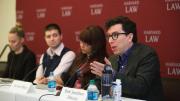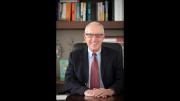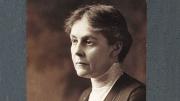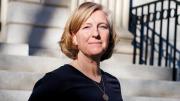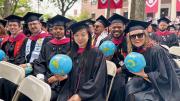There has been no shortage of events at Harvard on the public’s loss of trust in journalism and the prominence of fake news stories and outlets. In many ways, Thursday’s panel at the Berkman Klein Center for Internet & Society, moderated by Harvard Law School dean Martha Minow, was a practical outcome of those discussions. The panel, titled “Fake News, Concrete Responses: At the Nexus of Law, Technology, and Social Narratives,” presented four Berkman Klein staff members who talked about existing and potential tools with which to combat the wave of misinformation that escalated during the 2016 election cycle and shows no sign of slowing down today. “A lie can travel halfway around the world while the truth is putting on its shoes,” quoted Bemis professor of international law Jonathan Zittrain, a co-founder of the center. With “alternative facts” spreading faster than most outlets can reliably fact-check them, Minow asked: What kinds of tools can newsrooms use? How might those tools translate into the hands of the consumers of news?
Efforts by Google and Facebook to more rapidly fact-check news shared through social channels, and to flag unreliable sources, might be one way, said Nathan Matias, a Ph.D. candidate at the MIT Media Lab. He also mentioned the value of a hypothetical function that could notify users that an article had been fact-checked and was reliable. In a similar vein, An Xiao Mina, a Berkman Klein fellow who focuses on global Internet meme culture, talked about a platform, Check, that is already used by industry giants like ProPublica and organizations like Amnesty International. The tool can analyze content on social media, videos, and even private messaging apps to determine credibility. “Fact-checking methodologies need to adapt to also work on private feeds, like WhatsApp, not just the public feed,” she said, highlighting why Check’s private functionality is so critical.
One of the most interesting tools discussed at the panel doesn’t exist—yet. Zittrain proposed a “Voltaire button” for social-media platforms like Facebook, the use of which would send an implicit message of “I don’t agree with your views, but I defend to the death your right to say them.” The panelists joked that such a button would allow for an increase in respectful, dissenting dialogue on social networks, something that is often difficult to achieve with the rather black-and-white option of “liking” a post. Zittrain also toyed with the idea of an interstitial pop-up on Facebook that would ask users if they were willing to proceed to a page whose credibility was as yet unverified, or under debate. The panelists agreed it was unclear whether such measures would play to the advantage of mainstream media players, like The New York Times, and to the disadvantage of smaller, local outlets.
Much of the conversation concerned fact-checking the news that first hits screens through push notifications and Tweets, because few readers, Matias pointed out, take the time to click beyond a headline. Sandra Cortesi, director of the youth and media program at Berkman Klein, emphasized that young people, partly due to their reliance on social networks, but also because of their different interpretations of what makes a news outlet credible, are especially vulnerable to the spread of misinformation in this way. As a potential solution, Zittrain described a new tool that news outlets might use to notify readers about a so-called information recall, asking them to revisit a breaking-news story once the dust had settled. Ideally, this would train readers to become more discerning consumers of the news—helping them understand that a first-draft article often gets the story wrong. “It’s just so easy,” he said, “to paint a mosaic of true things that paints a totally false picture.”
